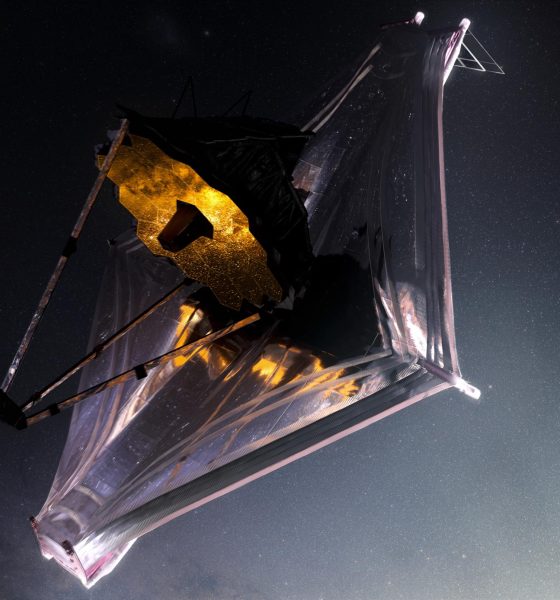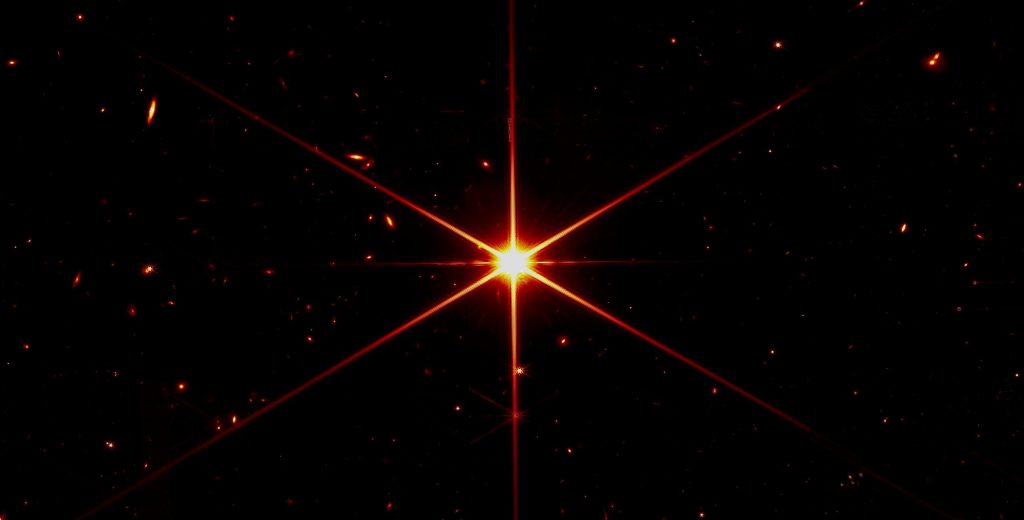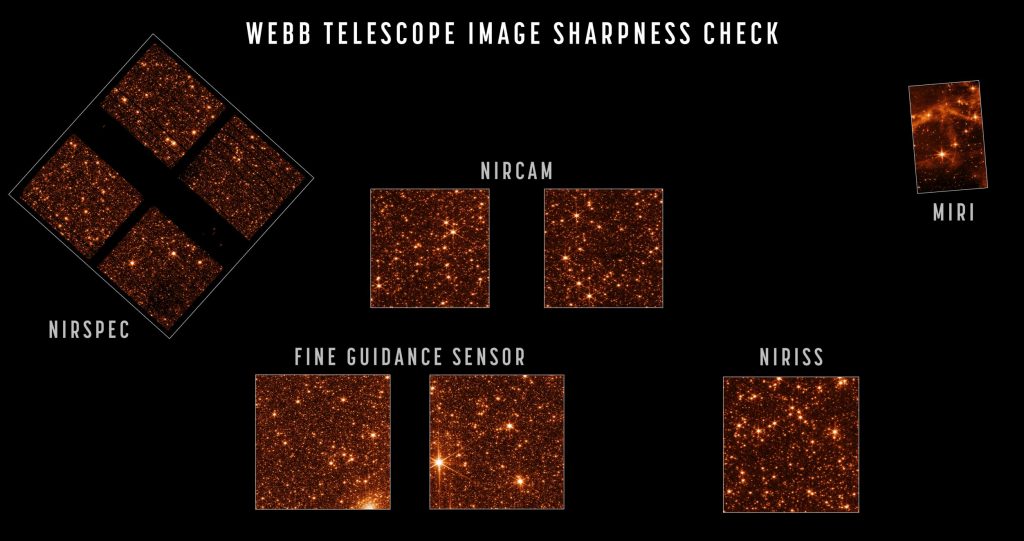

News
NASA’s Webb Telescope mirror crushes “most optimistic predictions” after final alignment
NASA says that the nascent James Webb Space Telescope’s (JWST) “optical performance…continues to be better than the…most optimistic predictions” after completing the alignment of its record-breaking mirror.
Between 7 and 14 years behind schedule and over budget by a factor of 2 to 10, an Arianespace Ariane 5 rocket sent the Webb Telescope on its way to deep space on December 25th, 2021. Weighing 6.2 tons (~13,600 lb), JWST was almost half as heavy at liftoff as NASA’s iconic Hubble Space Telescope despite packing an unprecedented origami-like mirror with more than six times Hubble’s total collecting area. The combination of extreme mass reduction and extraordinary complexity required to launch such a large mirror so far from Earth with a rocket like Ariane 5 helps to partially explain why the Webb Telescope took so long (~18 years) and cost so much (~$9.7 billion) to design, develop, and build.
Nonetheless, launch it finally did. Ariane 5 did most of the work, sending the telescope on a trajectory that – with some help from its onboard thrusters – would guide it to the Sun-Earth L2 Lagrange point located some 1.5 million kilometers (~950,000 miles) from Earth. In perhaps the largest relief in the history of space-based observatories, the Webb Telescope’s immensely complex deployment process was then completed without a single major issue. 30 days after liftoff, the telescope – fully deployed – reached its operational orbit.
For the past four months, in comparison, almost all JWST work has focused on the less visible and far smaller processes of alignment and calibration. Each of JWST’s 18 main mirror segments has slowly but surely inched micrometer by micrometer into position while large swaths of the telescope slowly cooled to ambient temperatures – essential for maximum performance. Simultaneously, all of Webb’s primary instruments have achieved first light and entered the early phases of calibration and commissioning. Only after the instruments are painstakingly calibrated, the mirror is perfectly aligned, and crucial hardware is chilled to temperatures as low as -449°F (-267°C) can Webb begin to observe the universe and revolutionize large subsets of space science.

The first and most important step – mirror alignment – is now complete. The alignment process began in February 2022, six weeks after liftoff. First, images were captured with the unaligned mirror to help determine exactly what condition it was in. One by one, each of Webb’s 18 mirror segments were individually moved to determine which image each mirror was responsible for, which then allowed ground controllers to properly focus each mirror’s view of a target star. In a process known as “coarse phasing,” once those 18 points of light well-resolved and linked to a specific mirror segment, the segments were gradually steered on top of each other to produce a single image.
“Coarse” heavily undersells the almost unfathomable precision required to complete the step. To reach its full potential, each of the Webb Telescope’s mirror segments must be aligned to within 50 nanometers of each other. According to NASA, “if the Webb primary mirror were the size of the United States, each segment would be the size of Texas, and the team would need to line the height of those Texas-sized segments up with each other to an accuracy of about 1.5 inches.”

Fine phasing followed, involving an even more esoteric set of processes designed to focus the mirror as perfectly as possible. The resulting image was then tweaked to properly align it over the field of view of each of the Webb Telescope’s four main scientific instruments. Finally, some steps of the seven-step alignment process were redone or refined to fully optimize the mirror to the liking of its Earthbound creators and prospective users.
Ultimately, Webb Telescope alignment was extraordinarily successful, producing an image sharper and cleaner than even the “most optimistic predictions” made by its engineers. NASA says that the image is so detailed that it has effectively reached the physical resolution limit for a mirror the size of the Webb Telescope’s, meaning that it would have to violate the known laws of physics to resolve any more detail.

With mirror alignment complete, JWST has just one main hurdle left before science operations can begin: instrument commissioning. Commissioning is a catch-all phrase that covers a wide range of calibration, analysis, experiments, and optimization required to verify that JWST’s four main instruments are behaving as expected and accomplishing the work they were designed to do as accurately and reliably as possible.
At some point, the use of extraordinarily complex scientific instruments becomes more akin to an art form, and some degree of trust must be built up between scientists and their hopeful tools of the trade before they can confidently set chisel to marble and begin delving into the universe at unprecedented breadth and detail. If commissioning proceeds as smoothly as deployment and alignment, the JWST team could be ready to capture and share the telescope’s first actionable observations of the cosmos as early as July 2022.

News
Tesla aims to combat common Full Self-Driving problem with new patent
Tesla writes in the patent that its autonomous and semi-autonomous vehicles are heavily reliant on camera systems to navigate and interact with their environment.

Tesla is aiming to combat a common Full Self-Driving problem with a new patent.
One issue with Tesla’s vision-based approach is that sunlight glare can become a troublesome element of everyday travel. Full Self-Driving is certainly an amazing technology, but there are still things Tesla is aiming to figure out with its development.
Unfortunately, it is extremely difficult to get around this issue, and even humans need ways to combat it when they’re driving, as we commonly use sunglasses or sun visors to give us better visibility.
Cameras obviously do not have these ways to fight sunglare, but a new patent Tesla recently had published aims to fight this through a “glare shield.”
Tesla writes in the patent that its autonomous and semi-autonomous vehicles are heavily reliant on camera systems to navigate and interact with their environment.

The ability to see surroundings is crucial for accurate performance, and glare is one element of interference that has yet to be confronted.
Tesla described the patent, which will utilize “a textured surface composed of an array of micro-cones, or cone-shaped formations, which serve to scatter incident light in various directions, thereby reducing glare and improving camera vision.”

The patent was first spotted by Not a Tesla App.
The design of the micro-cones is the first element of the puzzle to fight the excess glare. The patent says they are “optimized in size, angle, and orientation to minimize Total Hemispherical Reflectance (THR) and reflection penalty, enhancing the camera’s ability to accurately interpret visual data.”
Additionally, there is an electromechanical system for dynamic orientation adjustment, which will allow the micro-cones to move based on the angle of external light sources.
This is not the only thing Tesla is mulling to resolve issues with sunlight glare, as it has also worked on two other ways to combat the problem. One thing the company has discussed is a direct photon count.
CEO Elon Musk said during the Q2 Earnings Call:
“We use an approach which is direct photon count. When you see a processed image, so the image that goes from the sort of photon counter — the silicon photon counter — that then goes through a digital signal processor or image signal processor, that’s normally what happens. And then the image that you see looks all washed out, because if you point the camera at the sun, the post-processing of the photon counting washes things out.”
Future Hardware iterations, like Hardware 5 and Hardware 6, could also integrate better solutions for the sunglare issue, such as neutral density filters or heated lenses, aiming to solve glare more effectively.
Elon Musk
Delaware Supreme Court reinstates Elon Musk’s 2018 Tesla CEO pay package
The unanimous decision criticized the prior total rescission as “improper and inequitable,” arguing that it left Musk uncompensated for six years of transformative leadership at Tesla.

The Delaware Supreme Court has overturned a lower court ruling, reinstating Elon Musk’s 2018 compensation package originally valued at $56 billion but now worth approximately $139 billion due to Tesla’s soaring stock price.
The unanimous decision criticized the prior total rescission as “improper and inequitable,” arguing that it left Musk uncompensated for six years of transformative leadership at Tesla. Musk quickly celebrated the outcome on X, stating that he felt “vindicated.” He also shared his gratitude to TSLA shareholders.
Delaware Supreme Court makes a decision
In a 49-page ruling Friday, the Delaware Supreme Court reversed Chancellor Kathaleen McCormick’s 2024 decision that voided the 2018 package over alleged board conflicts and inadequate shareholder disclosures. The high court acknowledged varying views on liability but agreed rescission was excessive, stating it “leaves Musk uncompensated for his time and efforts over a period of six years.”
The 2018 plan granted Musk options on about 304 million shares upon hitting aggressive milestones, all of which were achieved ahead of time. Shareholders overwhelmingly approved it initially in 2018 and ratified it once again in 2024 after the Delaware lower court struck it down. The case against Musk’s 2018 pay package was filed by plaintiff Richard Tornetta, who held just nine shares when the compensation plan was approved.
A hard-fought victory
As noted in a Reuters report, Tesla’s win avoids a potential $26 billion earnings hit from replacing the award at current prices. Tesla, now Texas-incorporated, had hedged with interim plans, including a November 2025 shareholder-approved package potentially worth $878 billion tied to Robotaxi and Optimus goals and other extremely aggressive operational milestones.
The saga surrounding Elon Musk’s 2018 pay package ultimately damaged Delaware’s corporate appeal, prompting a number of high-profile firms, such as Dropbox, Roblox, Trade Desk, and Coinbase, to follow Tesla’s exodus out of the state. What added more fuel to the issue was the fact that Tornetta’s legal team, following the lower court’s 2024 decision, demanded a fee request of more than $5.1 billion worth of TSLA stock, which was equal to an hourly rate of over $200,000.
Delaware Supreme Court Elon Musk 2018 Pay Package by Simon Alvarez
News
Tesla Cybercab tests are going on overdrive with production-ready units
Tesla is ramping its real-world tests of the Cybercab, with multiple sightings of the vehicle being reported across social media this week.

Tesla is ramping its real-world tests of the Cybercab, with multiple sightings of the autonomous two-seater being reported across social media this week. Based on videos of the vehicle that have been shared online, it appears that Cybercab tests are underway across multiple states.
Recent Cybercab sightings
Reports of Cybercab tests have ramped this week, with a vehicle that looked like a production-ready prototype being spotted at Apple’s Visitor Center in California. The vehicle in this sighting was interesting as it was equipped with a steering wheel. The vehicle also featured some changes to the design of its brake lights.
The Cybercab was also filmed testing at the Fremont factory’s test track, which also seemed to involve a vehicle that looked production-ready. This also seemed to be the case for a Cybercab that was spotted in Austin, Texas, which happened to be undergoing real-world tests. Overall, these sightings suggest that Cybercab testing is fully underway, and the vehicle is really moving towards production.
Production design all but finalized?
Recently, a near-production-ready Cybercab was showcased at Tesla’s Santana Row showroom in San Jose. The vehicle was equipped with frameless windows, dual windshield wipers, powered butterfly door struts, an extended front splitter, an updated lightbar, new wheel covers, and a license plate bracket. Interior updates include redesigned dash/door panels, refined seats with center cupholders, updated carpet, and what appeared to be improved legroom.
There seems to be a pretty good chance that the Cybercab’s design has been all but finalized, at least considering Elon Musk’s comments at the 2025 Annual Shareholder Meeting. During the event, Musk confirmed that the vehicle will enter production around April 2026, and its production targets will be quite ambitious.








